Disclaimer: This story is about pregnancy loss and miscarriages and contains images which may be triggering to some.
“It was late September and I was heading to my 20-week midwife appointment. It was a beautiful, warm, sunny day which matched my mood. This was a much-anticipated pregnancy milestone. HALFWAY! Because I had previously lost three first-trimester babies, we chose to get a DNA test this time, to discover the gender at 8 weeks. So we already knew we were having a baby girl and had been calling her by name for months. Noa became an integral part of our everyday lives. All five of her older siblings were excited, but her three sisters were EXTRA enthusiastic. My belly was rubbed and hugged and talked to and sang to at every opportunity. It seemed we couldn’t do anything without imagining what it would be like next year when Noa was here.
Noa is not typically a girl’s name (at least, not in America) but we have a naming format I really love. We look for obscure Bible names with meanings specifically related to that child. For every other child in our family, the meaning was clear when we chose the name. With Noa, it was the first time we left the meaning up to future interpretation. The female version of Noa means ‘motion’ or ‘movement.’ I had no idea what that would mean. When I was explaining this to a friend of mine I told her, ‘I’m not sure if this means she’ll be a dancer, or lead a movement… we’ll find out!’
At the midwife appointment, we spent almost an hour talking about how the pregnancy was going. We saved the doppler for last, like the icing on the cake. I climbed up on the table with anticipation and settled in. We chatted as the midwife got the gel out and placed the doppler on my belly. It had been six years since the last time I had been this far along into a pregnancy, which may account for my naïve optimism, but I was not concerned at all when she didn’t find a heartbeat right away.
She talked about how the placenta was probably in the way, and I was pretty sure I had felt the baby move just recently. Five minutes later, she still couldn’t find a heartbeat and I could tell she was concerned, which actually offended me a little because I was still positive everything was perfectly fine. I didn’t want to hear any negative talk, but I was thankful when she offered to call a doctor nearby and get me in for an ultrasound in thirty minutes. I was sure it would end well, but I wanted the reassurance.
My husband met me at the doctor’s office. I would have been okay on my own, I thought, but it was nice to have him there with me. Normally he would have been too far away to join me on short notice, but providentially, we happened to be in the same town at the same time so he arrived just minutes after me. The doctor called us back and got the ultrasound machine going right away. The first thing she asked me was if I had unusual anatomy and told me my uterus was abnormally small and empty. My adrenaline spiked.
‘WHAT?!?’ And then she apologized, ‘I’m so sorry… it appears your bladder is just so full it’s pushing your uterus way over to the side.’ I tried to calm my heartbeat and irritation and take a few deep breaths. Very quickly she confirmed, ‘Okay, yes. THERE’S your baby and a little heartbeat flicker.’ I smiled at my husband. I knew everything was okay. But then… why was she lingering so long? What else was she looking for? I looked all over the screen to try to figure out what she was seeing and noticed the heart rate numbers weren’t showing up like normal and the baby hadn’t moved at all.
I thought Noa must be sleeping and giving us a scare. Finally, after an awkwardly long silence, I asked, ‘Are you getting a heart rate?’ She said, ‘Actually, I’m not.’ She spoke very slowly. ‘And there’s blood flow to the placenta, but none to the baby.’ My adrenaline spiked again as I tried to understand. ‘WHAT?’ I caught only snatches of what the doctor was rattling off… 18 weeks size… call the midwife. My heart raced. All this time I had been convinced Noa was fine and it turns out she wasn’t fine at all. My baby was gone.
The midwife called and told us we should probably go over to the hospital for a second opinion and they would let us know what happens next. I nodded and said ‘okay’ numbly and tried to get off the phone before I lost the ability to speak at all. I couldn’t fully absorb what I was being told or I would have collapsed into a little pile on the floor. When we got out to the parking lot, my husband just wrapped his arms around me. I managed to shed a few tears, but I knew I had to hold it together.
We had driven separately and we were a long way from home. I needed to drive myself to the hospital. When I imagined the hospital, I thought of a conveyor belt or a roller coaster. I knew once I got on, I would feel like I had little to no control over the process or the speed. I lamented to my husband, ‘I don’t want to go to the hospital! I don’t even want to be around people right now.’ I expected him to just quietly ignore that as the wishful thinking I thought it was. Instead, he said, ‘Then let’s go home. We don’t need to go in right now. Let’s just go home.’ In my grief, I couldn’t think clearly for myself, but that simple statement of validation and support changed the trajectory of our entire experience.
At home, I finally found solitude and cried until my face hurt and I couldn’t breathe. I wailed in a visceral, spine-chilling way I’ve only seen in those movies that make you thankful it wasn’t real. I wished mine was a movie and I could walk out of the theater with a cold shiver running down my spine and say, ‘Whew, I’m so glad that wasn’t real life.’ But mine was real life.
Only the day before, I had been so blissfully happy and thankful for my surprise baby who came along late in life to fill our home with extra light and laughter. Only to find out today, fate had been mocking my joy behind my back for two whole weeks. The two opposite realities swirled in my mind until they formed a tornado that decimated my soul. I sat numb in this wasteland for two days. My baby was gone, my vulnerability had been betrayed, and I knew I would never be the same again.
Somehow, I managed to make the phone calls and advocate for everything I needed in order to grieve and heal properly. I leaned heavily into the belief I had choices, a gift given to me by my husband when he told me, ‘Let’s just go home.’ But it was God who moved the mountains and answered our prayers and the prayers of hundreds who joined us in faith. I knew I needed to honor the life of my baby and deliver her naturally. I needed to see her, hold her, and take pictures of her.
Having a D&C to remove her like a waste product was not an option for me. But because I had previously had one c-section (and in spite of the fact I had multiple natural births after that) we spent two days looking desperately for a provider who would be willing to oversee the induction. We finally found one, but he was two hours away. The expense would be much higher because they were not in the first-tier network with our insurance, but there’s no price you can place on something so precious. We were simply thankful God made a way.
The morning of my induction, I woke an hour early. My alarm was set for 5 a.m. but I jolted awake with a singular thought at 3:45. It was not gradual. My mind did not wander through until it stumbled upon this idea. I simply woke and it was there as if divinely placed. And I believe it was. I remembered weeks earlier reading a passing comment in a woman’s miscarriage story. It wasn’t the highlight of her story, it was simply a sentence about how they placed the baby’s body in water and they could see him better. I remember wishing she had shared a picture so I could see the difference.
I knew from my own miscarriages, when the baby was left in the open air, they quickly became unrecognizable. What would the baby look like underwater? As I lay in bed that morning, I wondered what my 18-week daughter would look like, how big she would be, and if it would feel barbaric to place her in water after she was born? Would it seem impersonal, like she was a specimen in a science lab? Would it seem irreverent to the nurses at the hospital? Would I look to them like a deranged, grieving mom who frantically wanted to preserve the body of her dead baby? I pushed these thoughts out of my mind as I realized I NEEDED this for my grieving process, and if I didn’t find the courage to ask, I would regret it for the rest of my life.
On the way to the hospital, I messaged my photographer, Heathyr Harkless. Heathyr runs a compassionate non-profit called House of Hopes that donates photos to families who have received the devastating news of various kinds. She had already volunteered to come out on her own birthday to photograph Noa’s birth, and here I was asking even more of her. I said, ‘I don’t want to be irreverent, but would you take pictures of my baby underwater?’
I am a professional photographer myself, so we discussed the logistics of it. The container would need flat sides to avoid distortion. It would need to be big enough, but not too big. Glass would be heavy and breakable… but would plexiglass be clear enough? I had already searched the web and there was no precedence for this. There was no website to tell us how to do it, and there was no time to practice. Heathyr ran around town shopping for fish tanks and sending me pictures of them. It was a lot of effort and we might look like complete idiots in the end when it flopped. But I had to try. I decided it was worth the risk.
The induction took all day. I took the first pill at 10 a.m. and it wasn’t until after 10 p.m. that I delivered Noa’s tiny little body. I knew those first few moments with her were important because her body was going to dry out and collapse quickly, so I held her and looked at her perfect little face. But Heathyr hadn’t been allowed in the room yet and they whisked Noa away from me before I even had time to grab my phone and take a picture. The doctor had to immediately start working on getting the placenta out so my bleeding would stop. It took the better part of an hour and by the time I got her back, Noa already looked disfigured. Gravity had not been kind and her skin was peeling as it stuck to every surface that touched her. Tears welled up in my eyes. I had missed it. I had missed my window of opportunity to document her perfect little face. All I had was the memory of that first moment that went by so fast. Would I be able to hold on to it forever? I was pretty sure it was already fading.
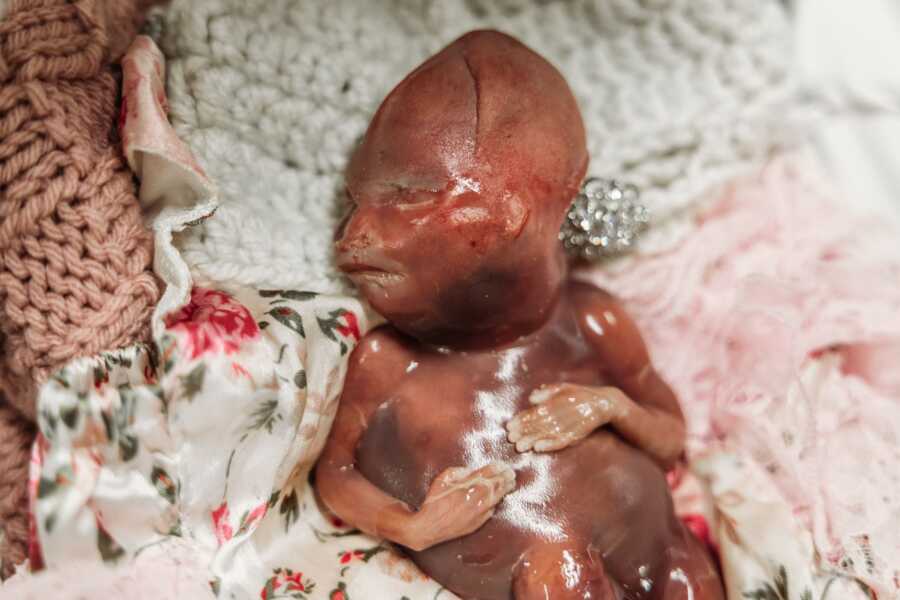

When the flurry of activity calmed down and we were finally alone with Heathyr, we decided to try placing Noa in the water. The nurses weren’t appalled at all; they were actually extremely supportive and offered the suggestion of using saline instead. They brought us several bottles and we filled the small tank. To my surprise, it didn’t feel weird to place Noa in the water. As she became weightless and slipped gently out of my hand, it felt just like I was returning her to the amniotic fluid that had been the only home she ever knew.
We looked through the side of the tank and the transformation was astonishing. She no longer looked flat and awkwardly placed. She looked natural and three-dimensional. Her facial features, that I had seen when she was first born, were instantly recognizable again. It was the most incredible thing I have ever witnessed. I was able to slip my hand in the water and hold her hand without feeling like I was going to break her. I placed both of my hands in the water and let her curl up in them and Heathyr took a picture. Her skin was still peeling but I could see right past it. She was so beautiful!
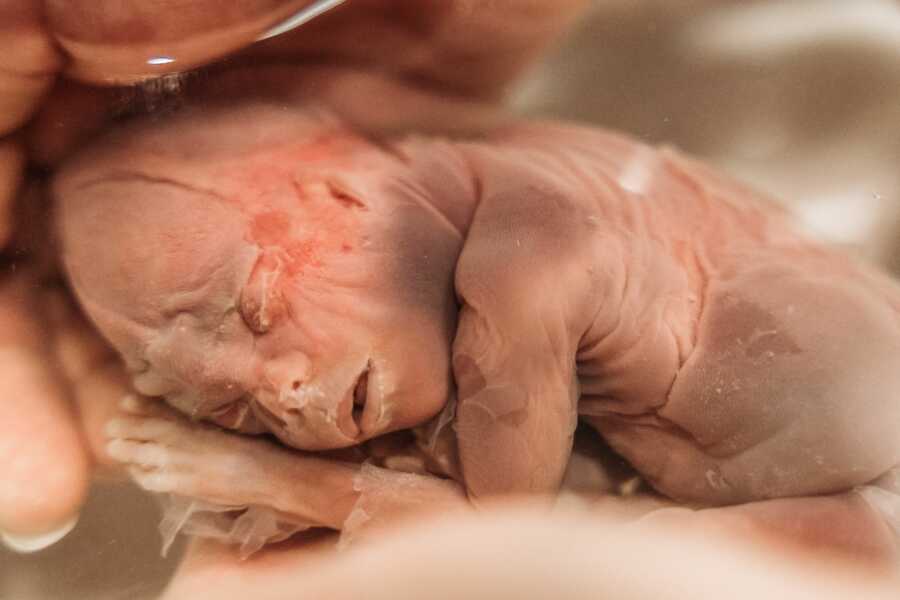
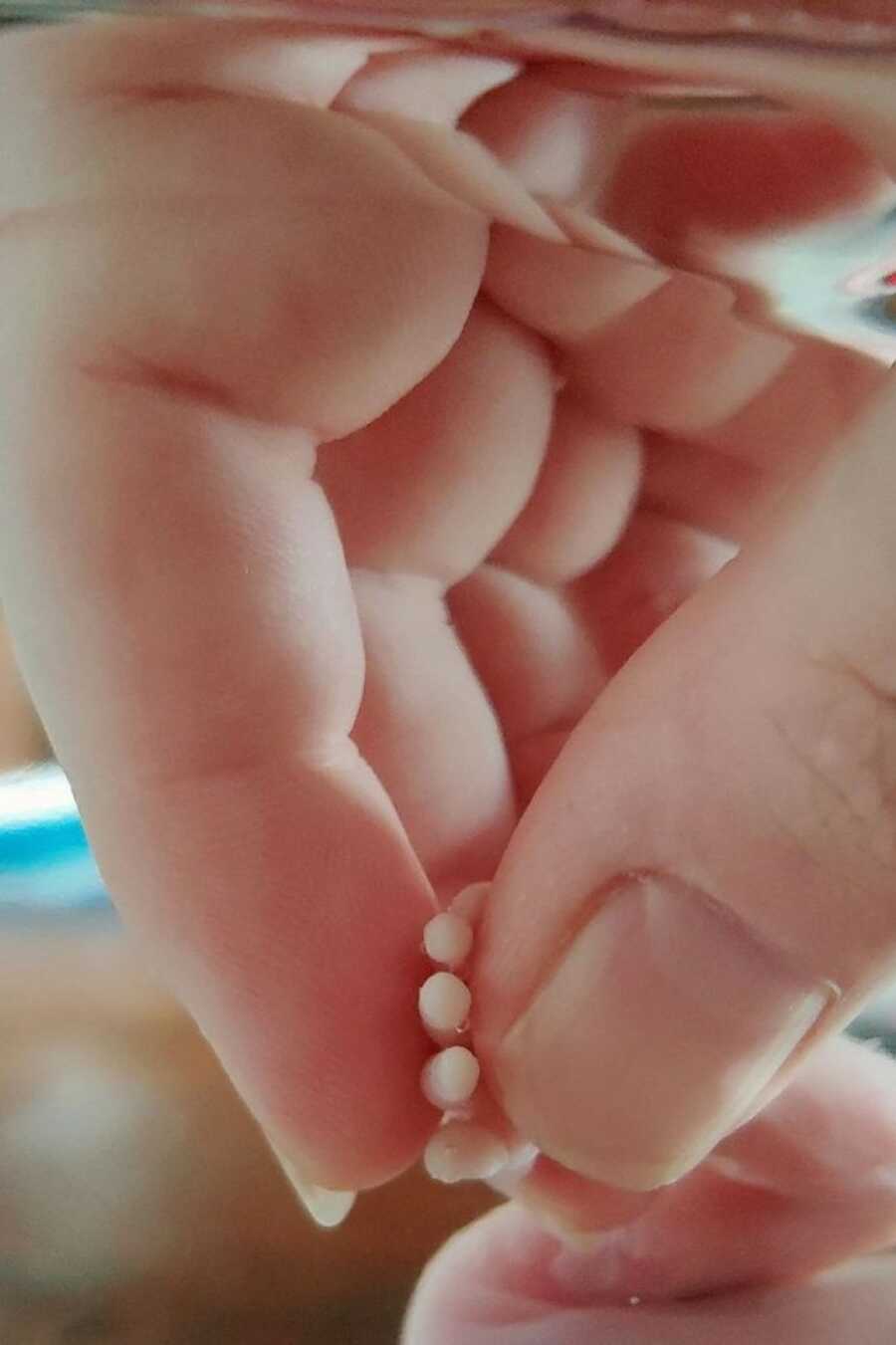
I stayed up until the early hours of the morning just staring at my daughter’s face and memorizing every detail. I didn’t want to fall asleep because I had no idea what condition she would be in when I woke up. But eventually, I couldn’t hold my eyes open anymore and I drifted off with Noa in the little tank of saline on the bedside table next to me. When I woke up a few hours later, I was pleasantly surprised to see she looked even better than she had before.
Her skin tone was not as red and some of the peeling skin had dissolved away. I took more pictures and prepared to go home. Thankfully, since she was less than 20 weeks old we were able to take her home with us. We transported her in a water-tight container and then placed her back in the small fish tank when we got home. The saline had to be changed every 6-8 hours so it would stay clear enough for good pictures. Over the next 24 hours, we were able to take hundreds of pictures and have many precious moments with our children.

My very favorite picture of Noa was taken the morning of her burial. She looked so much better after being in the saline for two days, and her skin had become so much smoother. I decided I wanted to try the picture of her in my hands again. My son grabbed his phone and took the picture for me since I wanted my hands to be the ones holding her. We placed a pillowcase behind the tank for a white background and I stood up on the toilet in the bathroom so my hands would enter the tank at the right angle.

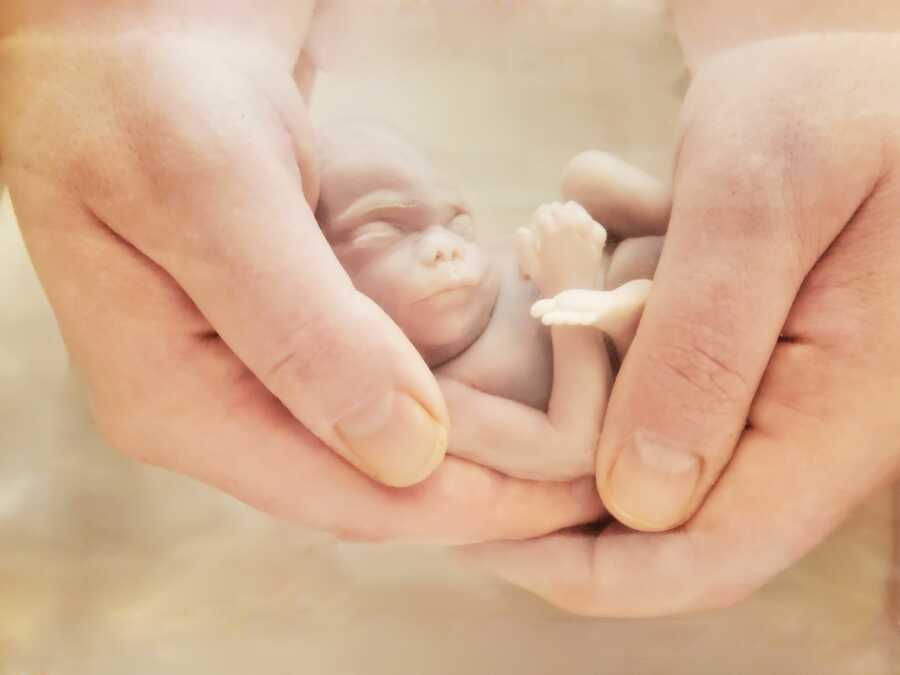
I was so weak from the delivery my husband had to help hold me up. But it was a perfect moment. The picture was exactly what I had hoped for. She looked so beautiful and peaceful, like a tiny little sleeping baby. I knew what my baby looked like and now I could remember it forever. Finally, I was at peace and ready to say goodbye.
When I see that picture of Noa now, I realize it is more important than just a stunning picture of my baby girl. It is hope for future moms who desperately want to know what their ‘angel baby’ really looked like and share it with others. It is the possibility for every grieving mom of a miscarried child to hear the healing affirmation: ‘Wow, your baby was so beautiful!’ It is a rare and wonderful glimpse into the secret world of the womb. It is proof of the personhood of all unborn children. Noa’s picture is Psalm 139:13 in photographic form: ‘For you created my inmost being; you knit me together in my mother’s womb.’ I knew I couldn’t keep such a gift all to myself.
Every mama should know this is possible for herself and for her friends. I hope by being vulnerable and sharing Noa’s story, more women will one day have beautiful pictures of their ‘angel babies.’ I want it to be the expectation instead of the exception. If pictures of these precious little ones will no longer be considered hideous and hidden away, but instead will be shared openly by every mama who feels the urge to do so, then Noa will have started a movement and lived up to the meaning of her name.”

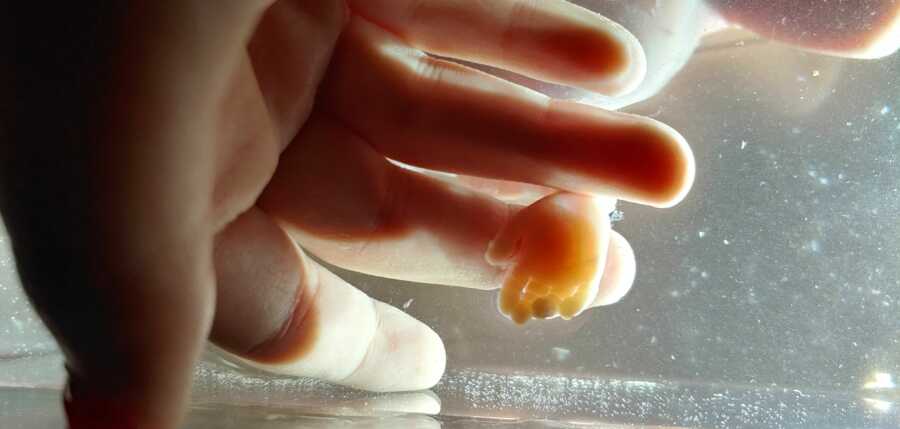
This story was submitted toLove What Matters by Christi Nelson.Submit your own story here.Be sure tosubscribeto our free email newsletter for our best stories, andYouTubefor our best videos.
Read more stories like this:
‘I opened Google and typed ‘pink discharge pregnant.’ Everything indicated it could be normal.’: Mom spreads miscarriage awareness, ‘Women are suffering in silence’
‘At 41 years old, I felt pregnant. ‘But how could I be? I have an IUD.’: Woman births rainbow baby after multiple miscarriages, becomes birth mom in adoption to give back
‘I waited 39 years to be a mom. I’m not going to waste a single moment saying anything negative.’: Mom teaches self-love to daughter
‘She just doesn’t want to go to school.’ At 18, I became a single mom living with undiagnosed pain.’: Chronic illness warrior becomes advocate with son’s help, ‘I couldn’t live without him’
PleaseSHAREthis story on Facebook to encourage others to cherish every moment and love what matters most.